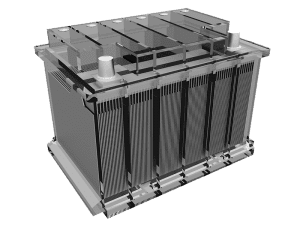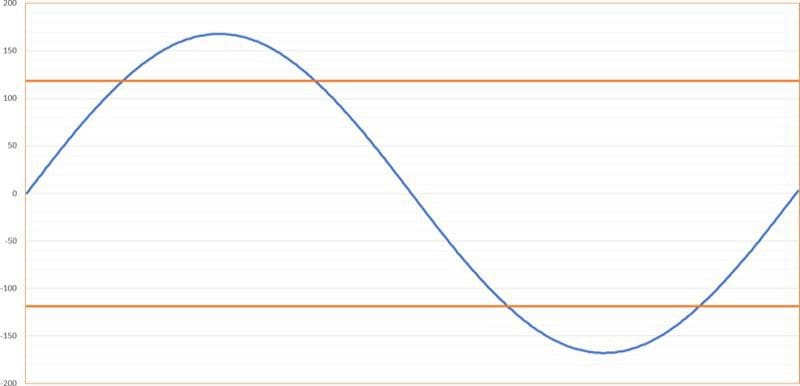 In our ongoing series of articles about car audio electrical theory, we are going to introduce the concept of alternating current power sources and signals. Understanding the basics of AC is crucial to understanding how a mobile audio system works. This article uses a lot of references to the electricity delivery systems used in our homes and offices to help establish a basic understanding of AC circuits. We’ll build on this foundation in this and subsequent articles to help form an understanding of the complexities of AC systems.
In our ongoing series of articles about car audio electrical theory, we are going to introduce the concept of alternating current power sources and signals. Understanding the basics of AC is crucial to understanding how a mobile audio system works. This article uses a lot of references to the electricity delivery systems used in our homes and offices to help establish a basic understanding of AC circuits. We’ll build on this foundation in this and subsequent articles to help form an understanding of the complexities of AC systems.
The Difference Between AC and DC
 The voltage produced by the electrical system in our vehicles is called direct current. The electrons flow in one direction from one terminal of the battery to the other (except when we are recharging the battery). While there are changes in the voltage level as we add loads to the circuit, or when the alternator starts recharging the battery, the direction of current flow to the electric and electronic devices in the vehicle never changes.
The voltage produced by the electrical system in our vehicles is called direct current. The electrons flow in one direction from one terminal of the battery to the other (except when we are recharging the battery). While there are changes in the voltage level as we add loads to the circuit, or when the alternator starts recharging the battery, the direction of current flow to the electric and electronic devices in the vehicle never changes.
Conversely, the power supplied by your local electric company to drive the lights and appliances our homes and at work is called alternating current. It has this name because the flow of electrons changes direction 60 times a second. Yes, this sounds weird. Who would want their power to go back and forth? Don’t fret; we’ll explain it all shortly. Just keep reading.
Power Loss in Transmission Wires
 Researchers believe that the first electrical power source was a clay pot that contained tin plates and an iron rod. If filled with an acidic solution like vinegar, a voltage would be produced on the metal terminals. The belief is that this first battery was created more than 2,000 years ago. All batteries are direct current power sources.
Researchers believe that the first electrical power source was a clay pot that contained tin plates and an iron rod. If filled with an acidic solution like vinegar, a voltage would be produced on the metal terminals. The belief is that this first battery was created more than 2,000 years ago. All batteries are direct current power sources.
Using electricity to do work started to become popular in the late 1800s, and as such, the need to deliver electricity to homes and offices became necessary. The problem with delivering power over long distances is voltage loss in the wires because of their resistance.
As we know from Ohm’s law and the power calculations we have recently discussed, the power in a circuit is directly proportional to the current and voltage (P = I x V) in the circuit. Power is also proportional to the square of current in the circuit relative to the resistance (P = I^2 x R). If we can transmit power with more voltage and less current, less power is wasted in the transmission wires.
Adoption of Alternating Current
A significant benefit of alternating current power supplies in commercial and residential applications is that it is easy to change the relationship between voltage and current using a transformer. A transformer is a device that uses magnetic fields to increase or decrease the voltage to current ratio. For example, an ideal 2:1 transformer would convert 10 volts and five amps of AC to five volts and 10 amps.
George Westinghouse is credited with the popularization of the delivery of AC power to homes, thanks to being awarded the contract to supply power to light the 1893 World’s Fair Columbian Exposition. Westinghouse used transformers based on patents he purchased from Lucien Gaulard and John Dixon Gibbs. Gaulard and Gibbs invented the transformer in London in 1881.
 The output of a generator in a nuclear, coal or hydroelectric plant is 20 to 22 kilovolts. This voltage is stepped up to between 155,000 to 765,000 volts using a transformer for distribution around the state or province. Most of the high-voltage towers you see along the highway or in clearings have around 500,000 volts flowing through the three power conductors.
The output of a generator in a nuclear, coal or hydroelectric plant is 20 to 22 kilovolts. This voltage is stepped up to between 155,000 to 765,000 volts using a transformer for distribution around the state or province. Most of the high-voltage towers you see along the highway or in clearings have around 500,000 volts flowing through the three power conductors.
Each city or portion of a city will have some type of electrical substation where the electricity from these high-voltage lines is stepped down to lower voltages for distribution around different neighborhoods. These voltages are usually in the 16kV range to maintain an adequate level of transmission efficiency over these short to moderate distances. Transformers in enclosures at the side of the road or installed underground convert that voltage to the 120V feeds that run to the electrical panels in our homes.
By way of an example, let’s look at 1 mile of 8 AWG stranded cable. According to the American Wire Gauge standard, 1 mile of 8 AWG copper wire will have a maximum resistance of 3.782 ohms and an ideal resistance of 3.6 ohms.
 If we want 5,000 watts of power delivered through this mile of cable, there will be some energy lost to the resistance in the cable. If we transmit our power at 240 volts, there will be 20.83 amps of current flowing in the cable. With a resistance of 3.6 ohms, the cable itself causes a loss of 1562.5 and we lose 75 volts across the cable. Clearly, low-voltage signal transmission over long distances doesn’t work.
If we want 5,000 watts of power delivered through this mile of cable, there will be some energy lost to the resistance in the cable. If we transmit our power at 240 volts, there will be 20.83 amps of current flowing in the cable. With a resistance of 3.6 ohms, the cable itself causes a loss of 1562.5 and we lose 75 volts across the cable. Clearly, low-voltage signal transmission over long distances doesn’t work.
If we increase the voltage up to 16,000 volts, the power loss in the cable drops to 0.3125 watts and we only lose 1.125 volts to the cable.
High-voltage transmission lines are how electric companies can deliver megawatts of electricity over long distances with minimal power loss. At 500,000 volts, we can transmit 1 megawatt of electricity over 100 miles and lose only 720 volts. That’s 0.144 percent!
OK, enough about the relationship of AC power and voltage. Let’s talk about audio systems.
A First Look at Audio Signals
Unlike the 60Hz AC waveform that feeds our homes, audio signals contain voltage information that mimics the changes in air pressure that we would perceive as sound. In most cases, sounds are recorded using a microphone that works in the opposite way a speaker does. Sound energy moves a small diaphragm that includes a coil of wire. The coil of wire moves past a fixed magnet. The motion of the coil through the magnetic field induces a voltage in the wire. The distance the diaphragm moves determines the amplitude of the voltage signal. Louder sounds produce higher voltages.
Below is a picture of an audio waveform as seen on an oscilloscope. The person speaking said the word audio.

Understanding Power in Alternating Current Circuits
The basic concept of power in an AC circuit is the same as for a DC circuit, but some calculations need to be completed before we can apply Ohm’s law. We’ll look at the 120V, 60Hz residential power supply to explain the math in the simplest of terms.
To measure power, we need to look at the amount of work completed over a given period. In the case of a light bulb plugged into an outlet, the filament doesn’t care which direction current is flowing, but the amount of light and heat created depends on the amplitude of the voltage supplied. The work done by the bulb is calculated by the number of electrons that flow through the bulb for a given amount of time.
To determine the work done by an AC voltage, we need to calculate the value of that signal that does the same amount of work as a DC voltage. This value is called the RMS or root mean square value and is 1/sqrt 2, or 0.70711 for sine waves. For our 120V power feed coming out of the wall, 120V volts is the RMS voltage. The peak voltage is about 167.7 volts. To be clear, the value of 0.70711 only works for a sinusoidal waveform. The RMS value of a square wave is 1.0 and for a symmetrical triangle wave is 0.577.
By definition, the RMS AC voltage can perform the same amount of work as DC voltage of the same value.
The image below shows a single cycle of a sinusoidal waveform. The peak voltage is 167.7 volts, and the two orange lines define the RMS value of 120V.

Basic Understanding of Alternating Current Sources and Signals
For this article, the takeaway is that the audio waveforms on the preamp and speaker wires in our stereo system are alternating current signals. In the next article, we will discuss the concept of frequency and amplitude in more detail.
This article is written and produced by the team at www.BestCarAudio.com. Reproduction or use of any kind is prohibited without the express written permission of 1sixty8 media.
